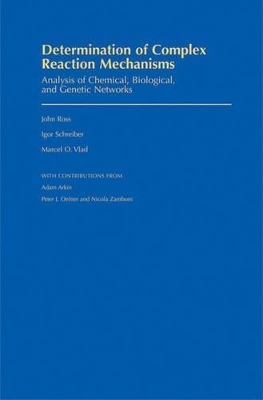
Determination of Complex Reaction Mechanisms
Oxford University Press Inc (Verlag)
978-0-19-517868-5 (ISBN)
In a chemical system with many chemical species several questions can be asked: what species react with other species: in what temporal order: and with what results? These questions have been asked for over one hundred years about simple and complex chemical systems, and the answers constitute the macroscopic reaction mechanism. In Determination of Complex Reaction Mechanisms authors John Ross, Igor Schreiber, and Marcel Vlad present several systematic approaches for obtaining information on the causal connectivity of chemical species, on correlations of chemical species, on the reaction pathway, and on the reaction mechanism.
Basic pulse theory is demonstrated and tested in an experiment on glycolysis. In a second approach, measurements on time series of concentrations are used to construct correlation functions and a theory is developed which shows that from these functions information may be inferred on the reaction pathway, the reaction mechanism, and the centers of control in that mechanism. A third approach is based on application of genetic algorithm methods to the study of the evolutionary development of a reaction mechanism, to the attainment given goals in a mechanism, and to the determination of a reaction mechanism and rate coefficients by comparison with experiment. Responses of non-linear systems to pulses or other perturbations are analyzed, and mechanisms of oscillatory reactions are presented in detail. The concluding chapters give an introduction to bioinformatics and statistical methods for determining reaction mechanisms.
1.: Introduction
1.1: Some Basic Definitions
1.2: Introduction to Classical Identification
2.: Introduction to Chemical Kinetic Processes
2.1: Macroscopic, Deterministic Chemical Kinetics
2.2: Disordered Kinetics
2.3: Fluctuations
3.: A Brief Review of Methodology for the Analysis of Biochemical Reactions and Cells
3.1: Introduction
3.2: Measurement of Metabolite Concentrations
3.3: Principles and Applications of Mass Spectrometry
3.4: Genome-Wide Analyses of mRNA and Proteins
3.5: Fluorescent Imaging
3.6: Conclusions
4.: Computations by Means of Macroscopic Chemical Kinetics
4.1: Chemical Neurons and Logic Gates
4.2: Implementation of Computers by Macroscopic Chemical Kinetics
4.3: Computational Functions in Biochemical Reaction Systems
5.: Response of Systems to Pulse Perturbations
5.1: Theory
5.2: An Example: The Glycolytic Pathway
6.: Experimental Test of the Pulse Pertubation Method for Determining Casual Connectivities of Chemical Species in a Reaction Network
7.: Correlation Metric Construction: Theory of Statistical Construction of Reaction Mechanisms
8.: Experimental Test and Applications of Correlation Metric Construction
9.: Destiny Estimation
9.1: Entropy Metric Construction (EMC)
9.2: Entropy Reduction Method (ERM)
10.: Applications of Genetic Algorithms to the Determination of Reaction Mechanisms
10.1: A Shory Primer on Genetic Algorithms
10.2: Selection Regulation of Flux in a Metabolic Model
10.3: Evolutionary Development of Biochemical Oscillatory Reaction Mechanisms
10.4: Systematic Determination of Reaction Mechanism and Rate Coefficients
10.5: Summary
11.: Oscillatory Reactions
11.1: Introduction
11.2: Concepts and Theoretical Constructs
11.3: Experiments Leading to Information about the Oscillatory Reaction Mechanism
11.4: Examples of Deduction of Reaction Mechanism from Experiments
11.5: Limits of Stoichiometric Network Analysis
12.: Lifetime and Transit Time Distributions and Response Experiments in Chemical Kinetics
12.1: Lifetime Distributions of Chemical Species
12.2: Response Experiments and Lifetime Distributions
12.3: Transit Time Distributions, in Complex Chemical Systems
12.4: Transit Time Distributions, Linear Response, and Extracting Kinetic Information from Experimental Data
12.5: Errors in Response Experiments
12.6: Response Experiments for Reaction-Diffusion Systems
12.7: Conclusions
13.: Mini-Introduction to Bioinformatics
13.1: Clustering
13.2: Linearization in Various Forms
13.3: Modeling of Reaction Mechanisms
13.4: Boolean Networks
13.5: Correlation Metric Construction for Genetic Networks
13.6: Bayesian Networks
13.7: Some Other Illustrative Approaches
Index
| Erscheint lt. Verlag | 26.1.2006 |
|---|---|
| Zusatzinfo | 2 pp colourplates, numerous line drawings |
| Verlagsort | New York |
| Sprache | englisch |
| Maße | 163 x 241 mm |
| Gewicht | 515 g |
| Themenwelt | Naturwissenschaften ► Chemie ► Physikalische Chemie |
| ISBN-10 | 0-19-517868-8 / 0195178688 |
| ISBN-13 | 978-0-19-517868-5 / 9780195178685 |
| Zustand | Neuware |
| Haben Sie eine Frage zum Produkt? |
aus dem Bereich


